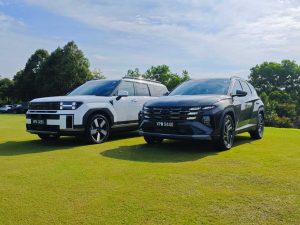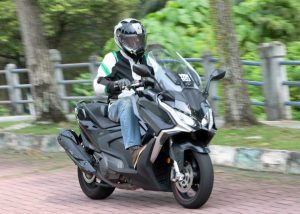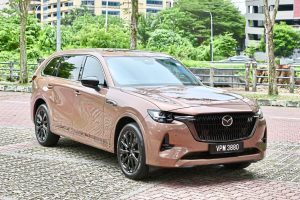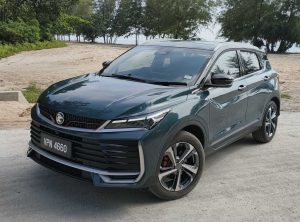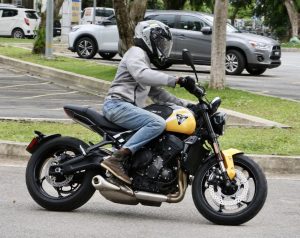TOYOTA Motor Corp (TMC) wants to launch compact hybrid cars in the A and B-segments in Asean in the near future, according to the automaker’s top executives.
“We want to introduce hybrid vehicles in the A and B-segments as soon as possible in Asean markets, featuring the latest technologies which have resulted in more compact, high-performance and fuel-efficient powertrains,” said Yoshiki Konishi, president and executive chief engineer of Toyota Daihatsu Engineering and Manufacturing Co Ltd, on the sidelines at the recent Idemitsu 1500 Super Endurance race at the Chang International Circuit in Buri Ram, Thailand.

bZ4X electric vehicle.
Konishi said that the new 2023 Prius, built on a second-generation Toyota New Global Architecture (TNGA) platform, features three key technologies.
“Compared with the first Prius (launched in 1997), fuel efficiency and passenger comfort have improved significantly due to reductions to the size and weight of the powertrain, as well as smaller battery sizes, resulting in better interior space, and lower costs of the hybrid system,” he said.

bZ4X electric vehicle.
Hao Quoc Tien, who is Toyota Motor Corp’s CEO for Asia Region, added, “We do have plans for hybrids in the A and B-segments. I can’t tell you the date yet, but they are coming soon. Toyota continues to innovate and offers alternatives.”
Hao also pointed out tha Toyota’s hydrogen-fuelled powertrain technologies align with Singapore’s recent announcement of a national strategy to develop hydrogen as a major decarbonisation pathway, and to support the island nation’s international climate commitment to achieve net zero emissions by 2050.

bZ4X electric vehicle.
Hydrogen power is only one of the multiple pathways towards carbon neutrality as envisioned by Toyota Motor Corp (TMC), which wants its customers to have choices of different powertrains.
These can include hydrogen internal combustion engine vehicle (HICEV), fuel cell electric vehicle (FCEV), battery electric vehicle (BEV), plug-on hybrid electric vehicle (PHEV), hybrid electric vehicle (HEV) and conventional internal combustion engines (ICE) powered by alternative fuels.

bZ4X electric vehicle.
Hao noted that while many challenges lie ahead on the road toward HICEVs, its success would see less employment shocks or disruptions in the automotive industry.
“If HICEVs can see mass commercialisation, we can preserve many jobs,” said Hao, who is also president of Toyota Motor Asia Pacific Pte Ltd.
The race in Thailand was also a platform for TMC president Akio Toyoda and his Rookie Racing privateer team to demonstrate the prowess of a hydrogen-powered GR Corolla H2 as well as a synthetic fuel-powered GR86.

Toyoda (centre) races under the pseudonym 'Morizo.'
Toyoda’s intent was to highlight that battery electric vehicles (BEVs) are not the only way to achieve a carbon neutral future, and hydrogen or synthetic fuel-powered cars could be better choices for slowing down climate change.
Hao said Toyota’s multiple pathways approach towards carbon neutrality is much more practical as there are different mobility and transportation needs such as trucking, logistics, and first and last-mile connectivity.

Hao.
On the diversity and different economic conditions in Asean markets, Hao noted that Malaysia serves as a good example.
“You have big cities where passenger cars dominate and in East Malaysia, pick-up trucks are a popular choice in many areas.”
“This goes back to Toyota’s philosophy of offering different choices for consumers. Asean automotive markets continue to grow, with rising motorisation rates (cars per 1,000 inhabitants),” he added.
At the event, the motoring press also had brief test drives of the Toyota bZ4X battery electric vehicle (BEV) and Mirai, which is a hydrogen-powered fuel-cell electric vehicle (FCEV) at a reserved area at the circuit, laid out with a long runway for straight off-the-line sprints, a short slalom exercise and an irregular surfaced section.

Mirai is hydrogen-powered.
Likely to be introduced in Malaysia in this year, following its recent launch in Thailand in November, the bZ4X comes in both front-wheel and all-wheel drive options, has a 71.4-kWh lithium-ion battery, and a travel range of up to 500km.
As expected from a BEV, the drive is near silent, without the noise or vibration of a combustion engine, and acceleration is effortless.
The bZ4X has responsive steering, a cabin with a Lexus-like premium look and feel, ample leg and headroom for 1.7-metre adults - that was the general impression we came away with after two quick rounds in the five-seater sports utility vehicle (SUV).
As for the five-seater Mirai sedan, again, there is no engine vibration or noise, and it delivered quick off-the-line sprints, as well as sharp, responsive handling during a quick slalom course.

Mirai.
It’s worth noting that the second-generation Mirai has a third hydrogen fuel tank added, contributing to a 30% increase in the car’s driving range to 650km (compared with its predecessor).
Powertrain layout was optimised by Toyota engineers to give the Mirai a 50:50 front:rear weight distribution.
In the fuel cell system, hydrogen and oxygen from the air combine in a chemical reaction to create electricity to power the electric motor.
The only emission produced by a hydrogen fuel cell is water vapour.
The Mirai promises easy refuelling in five minutes or less.
In November 2022, Thailand’s first hydrogen refuelling station was launched in Pattaya, Chonburi and the Mirai will be offered as a limousine service car between U-Tapao International Airport and Pattaya, in a collaboration between Toyota Motor Thailand, BIG (Bangkok Industrial Gas) and Thai state-owned oil and energy giant PTT.

